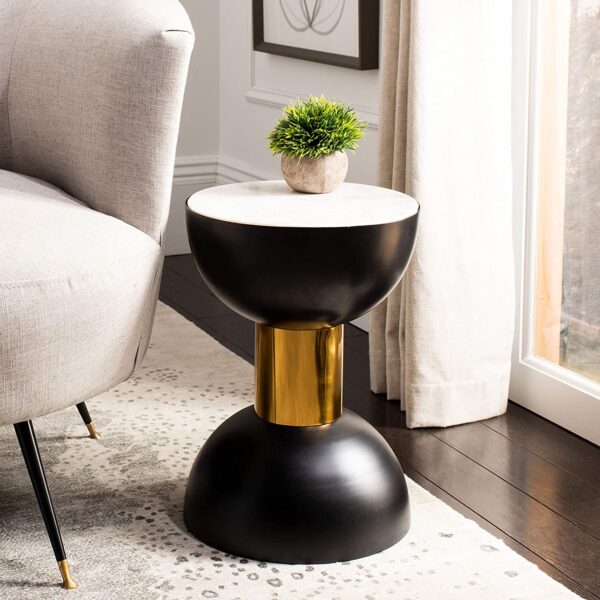When I first moved into my apartment, I quickly realized that I needed more than just functional furniture—I wanted pieces that were stylish and reflected my personality. That’s when I discovered the charm and utility of decorative end tables. These small yet impactful pieces can transform a room, add character, and serve multiple functions. In this comprehensive guide, we’ll explore everything you need to know about decorative end tables—from styles and materials to tips on choosing the perfect one for your space.
Table of Contents
- What Are Decorative End Tables?
- Types of Decorative End Tables
- Materials Used in Decorative End Tables
- Benefits of Decorative End Tables
- How to Choose the Perfect Decorative End Table
- Decorating Tips for End Tables
- Pros and Cons of Decorative End Tables
- Comparison Table of Popular Decorative End Tables
- FAQs
What Are Decorative End Tables?
Decorative end tables, also known as accent tables or side tables, are versatile pieces of furniture designed to add aesthetic appeal to a space while providing practical functionality. They can be placed next to sofas, chairs, or beds and serve as a surface for lamps, drinks, books, and decorative items.
Types of Decorative End Tables
Accent Tables
Accent tables are designed to stand out. They often feature unique shapes, colors, or materials that draw attention. An accent table can be a great way to inject a pop of color into your decor.

Nightstands
While primarily functional, nightstands can also serve as decorative elements in the bedroom. They offer space for night-time essentials like lamps, books, or alarm clocks while reflecting your style.
Cabinets and Storage Tables
These tables combine form and function. They provide storage while also acting as decorative pieces. Great for smaller spaces, they allow for organization without sacrificing style.

Materials Used in Decorative End Tables
The material of your decorative end table can significantly influence its look and durability. Here are some common materials:
- Wood: Classic and versatile, wooden tables add warmth and can be stained or painted.
- Metal: Offering a modern feel, metal tables can be sleek and minimalist or ornate and intricate.
- Glass: Perfect for small spaces, glass tables create an airy feel and allow other elements to shine.
- Marble: Luxurious and stylish, marble can add elegance but should be maintained properly.
Benefits of Decorative End Tables
Decorative end tables offer numerous advantages that go beyond just aesthetics. Here are some key benefits:
- Space Efficiency: They provide additional surfaces without taking up too much space.
- Versatility: These tables can be used in various rooms and settings.
- Personal Expression: They allow you to showcase your personality and style.

How to Choose the Perfect Decorative End Table
Choosing the right decorative end table can be a daunting task, but here are some key considerations:
- Size: Ensure the table complements the surrounding furniture in height and width.
- Style: Select a style that aligns with your existing decor.
- Function: Consider what you’ll be using the table for before making a purchase.
Decorating Tips for End Tables
Now that you’ve chosen the perfect table, here are some tips for styling it:
- Layering: Use a mix of heights with decor items like books, lamps, and plants.
- Balance: Achieve harmony by varying the shapes and sizes of your decor.
- Personal Touch: Incorporate personal items, like framed photos or souvenirs, for a unique feel.

Pros and Cons of Decorative End Tables
Pros
- Add character to any room.
- Provide functional surfaces for various uses.
- Can be easily moved to refresh your space.

Cons
- May take up space if not well chosen.
- Some designs may be less durable than others.
- Requires regular cleaning and upkeep, especially if made from certain materials.
Comparison Table of Popular Decorative End Tables
| Type | Material | Price Range | Best For |
|---|---|---|---|
| Accent Table | Wood, Metal | $100 – $500 | Living Rooms, Entryways |
| Nightstand | Wood, MDF | $50 – $300 | Bedrooms |
| Storage Table | Wood, Glass | $100 – $400 | Small Spaces |

FAQs
What is the difference between an end table and a side table?
While the terms are often used interchangeably, end tables are usually placed next to seating areas, whereas side tables can be used alongside any furniture.

Can I use a decorative end table in small spaces?
Absolutely! Look for narrow or round tables that fit well next to furniture without overwhelming the room.
How high should a decorative end table be?
The standard height is usually 24-30 inches. It should be level with the arm of your sofa or chair for optimal comfort.
Are decorative end tables easy to move around?
Many decorative end tables are lightweight, making them easy to reposition as needed for decorating or cleaning.
What should I place on my decorative end table?
Consider using a mix of functional and decorative items, like lamps, books, plants, or personal keepsakes, to create an inviting look.
In conclusion, decorative end tables are not just functional—they’re also a significant part of your home’s aesthetic. They provide a canvas for your creativity and a chance to showcase your personal style. Whether you’re a minimalist, a maximalist, or somewhere in between, there’s a decorative end table that’s perfect for you. So go ahead, express yourself and transform your space with the beauty and functionality of decorative end tables!